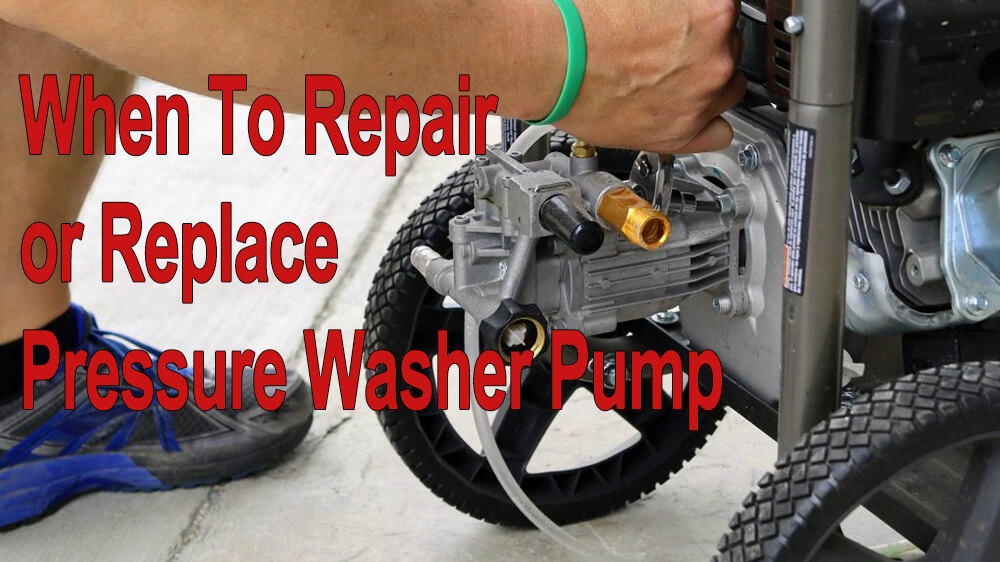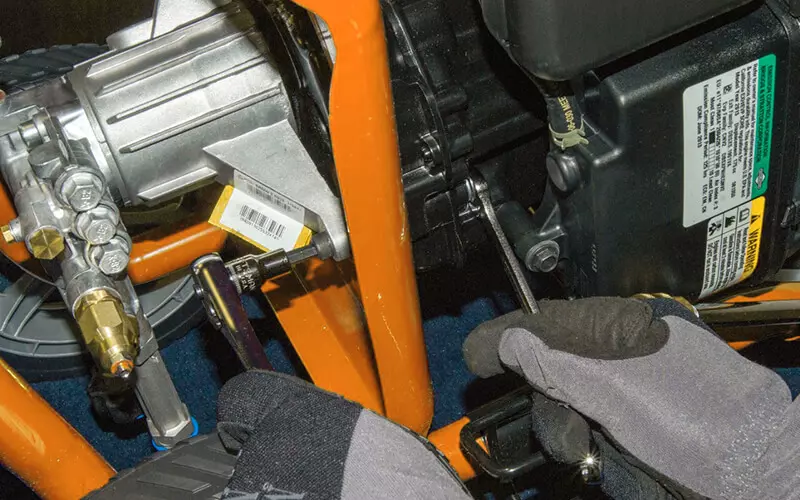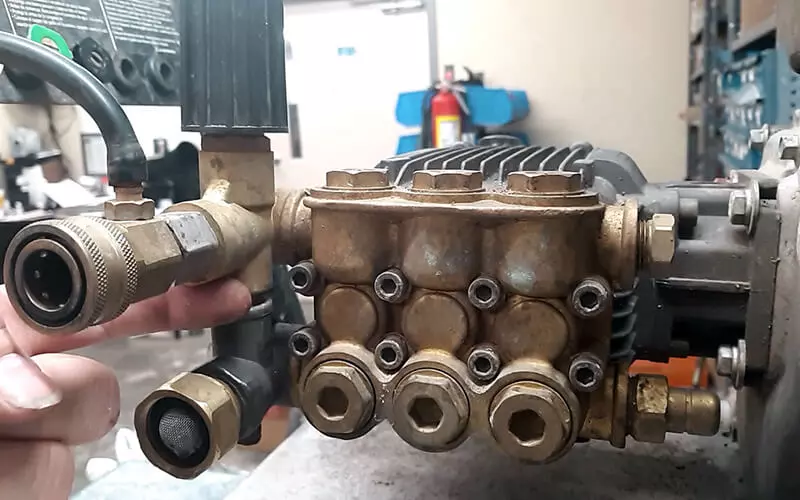04Sep 2024
table of contents

Pressure washers are ideal for quickly cleaning everything from home driveways to removing stubborn grease in industrial environments. Provides powerful water flow to complete cleaning tasks quickly and significantly increase efficiency and effectiveness.
However, pressure washers, like any intricate machine, can encounter issues, particularly with the pump. Common problems such as leaks, pressure surges and deteriorating seals and valves can greatly impair machine's function. If not discovered in time, may eventually lead to complete failure.
In this article, BISON will help you decide whether to repair or replace pressure washer pump. You will learn the signs of pump failure, and get useful tips to prolong the lifespan of pump.
First, high pressure washer pumps are available in several designs, each with its own benefits and lifespan. Let's explore them briefly. Axial cam pumps offer a simple design and are cost-effective, generally lasting between 300 to 800 hours. They are commonly found in household-grade pressure washers. Triplex piston pumps are gold standard for commercial and industrial applications due to their rugged construction and efficiency. These pumps have a longer service life, often exceeding 1000 hours with proper maintenance. Finally, swing plate pumps are another cost-effective option often found on entry-level machines. Although not as long-lasting as triplex pumps, they still provide a decent lifespan, usually 300 to 400 hours. Knowing about these types can guide your repair or replacement choices, considering the pump's purpose and durability.
But when these signs appear, it’s time to consider repairing or replacing pressure washer pump early.
Leaks can often be attributed to worn seals or fittings, including faulty water seals, damaged ceramic plungers, or compromised O-rings. If the leak is small and parts are accessible, repair may be a viable option. However, a severe leak may indicate more severe internal damage that requires replacement.
Pumps usually have an oil body that contains oil that keeps pressure washer pump body lubricated. If the oil in this pump is any color other than the standard oil color, there is water in the oil end of the pump. Usually caused by seal failure. If not taken care of quickly, this can cause severe damage to pump's internal structure. Empty the oil, and replace any damaged components or oil seals in the pressure washer pump's crankcase.
After removing pressure washer pump head, there are usually three plungers behind pressure washer pump head and in the pump body. They are connected to the connecting rods and crankshaft. If you shake the plungers and they appear to be loose, pressure washer pump needs to be replaced. You will usually first notice a drop in pressure, and in some cases there may be no pressure or a pulsating effect. A damaged or loose piston guide means pressure washer pump needs to be completely replaced. You can take it to a service center and ask them to advise or replace pressure washer pump.

Visible scratches on the inside of pressure washer pump head will compromise its integrity and prevent it from being resealable. In this case, replacement is usually recommended to ensure reliable performance, but the cost of replacing pressure washer pump head may also be relatively high.
Usually caused by prolonged pressure or improper use, it becomes very hot and melts, or internal parts melt and stick. Meltdowns usually require replacement because the internal damage is usually severe.
If your pressure washer pump runs too long with low or no oil and starts making loud noises or the pressure drops repeatedly, it likely means the pump is burned out. Overheating can damage the oil end of the pump, and replacing it is the only option. Always operate pressure washer pump on a flat surface, using it on a slope can lead to inadequate lubrication.
Winter exposure to freezing temperatures can cause water inside the pump to freeze, causing cracks and serious damage. If pressure washer pump freezes and develops cracks or leaks, it usually needs to be replaced.
The pump in a pressure washer is a type of positive displacement pump. If you know how a pump works, it likes to pull water out of pressure washer pump head. If you don't use an unloader to help relieve pressure from pump head, the water has nowhere to go but out of pressure washer pump. If unloader is not used or installed improperly, and pump is equipped with a trigger gun, water has nowhere to go; this is called pressure retention within pump or a dead pump. Once the pump dies, you can damage pump through an explosion, or simply break the threads in the pump body. Loose fittings or a loose or pushed check valve cover can damage the threads on the cover and pump head. The two most common ways this happens is if a machine designed as an open gun system has a trigger gun installed or if unloader is installed backwards. If you've already done this, it's time to replace pressure washer pump.
As a pressure washer pump ages, its efficiency decreases and problems occur more frequently. Older pressure washer pumps that are nearing the end of their expected life may be better replaced rather than repaired, especially if they have failed multiple times. At the same time, in some areas, the labor cost of repair is even higher than replacing a new pressure washer pump.

Pressure washer pumps require regular maintenance. After long term use, it's critical to maintain your pressure washer pump during inspections.
By carefully evaluating these factors, you can better decide whether to repair or replace your pressure washer pump. Knowing potential issues and the condition of your equipment helps maintain its performance and longevity. Read on to discover effective practical tips that can extend the life of your pressure washer pump.
Proper maintenance and careful use can significantly extend life of your pressure washer pump. Here are some helpful tips:
Use right cleaning solutions: Only use detergents made for pressure washers. This prevents internal corrosion and seal damage.
Regularly check: Check and replace seals, O rings and gaskets as needed.
Change oil regularly: Oil ensures pressure washer pump's moving parts run smoothly and reduces friction. Adhere to pressure washer manufacturer's oil change guidelines to prevent premature wear and keep operations running smoothly.
Flush the system: Clean water after each use, especially if you've used detergent. Prevent any chemical residues from settling inside pressure washer pump.
Use a water filter: Use a water filter to trap debris and protect pressure pump. Contaminants can scratch and harm the internal components of the pressure washer pump, leading to early failure.
Avoid overheating: Allow regular breaks for pressure washer pump during extended use to prevent overheating. Running continuously without pauses can lead to overheating and damage.
Proper winter storage: Properly winterize pressure washer pump when not in use. Drain all water from pump and hoses. Store in a dry, frost free location to prevent freezing and cracking.
Despite high pressure washer pumps are durable, you must watch out for signs of abnormality. And perform regular and proper maintenance to prolong its life. Doing so keeps your pressure washer dependable, efficient and effective over the long term. A well maintained and correctly used pressure washer not only works better but also minimizes repair frequency and costs, ensuring the best value and long lasting performance.
inquiry form here
BISON BLOG, All the latest news and views from Bison Machinery.
Related Articles
why does your pressure washer have surging or pulsing when to repair or replace pressure washer pumpRelated Products